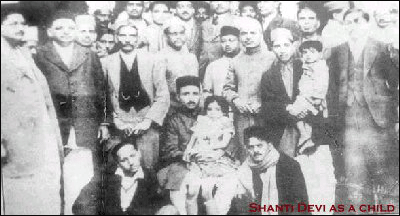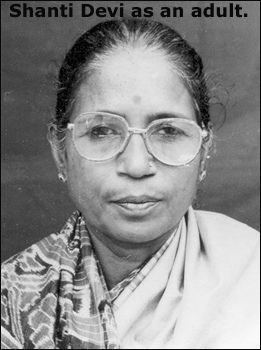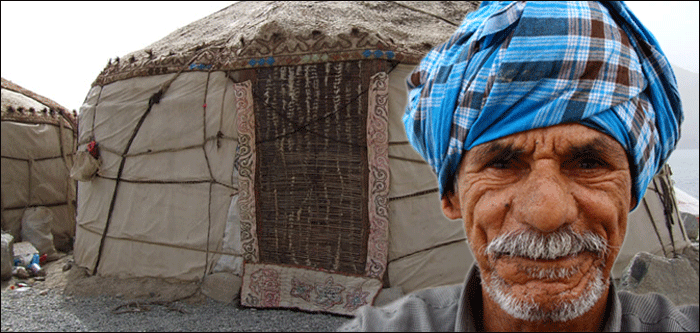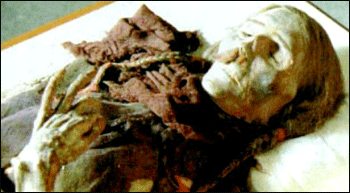On January 18,1902, a daughter was born to a family named Chaturbhuj, residents of Mathura, India. Her name was Lugdi. When Lugdi was 10, a marriage was arranged with a man named Kedarnath Chaube, a shopkeeper in the same village. After puberty, Lugdi became pregnant for the first time but her child was stillborn following a Cesarean section. During her second pregnancy, Kedarnath took her to the government hospital at Agra, where a son was born, again through a Cesarean. There were some complications, however, and several days later, on October 4, Lugdi's condition deteriorated and she died at 10 A.M.
 One year ten months and seven days after Lugdi's death, on December 11, 1926, a beautiful daughter was born to Babu Rang Bahadur Mathur of Chirawala Mohulla, a small locality of Delhi. The girl was named Shanti Devi.
Shanti was unusually quiet and hardly spoke until she was four years old. When she started talking, she surprised her family by telling them, "This is not my real home! I have a husband and a son in Mathura! I must return to them!"
One year ten months and seven days after Lugdi's death, on December 11, 1926, a beautiful daughter was born to Babu Rang Bahadur Mathur of Chirawala Mohulla, a small locality of Delhi. The girl was named Shanti Devi.
Shanti was unusually quiet and hardly spoke until she was four years old. When she started talking, she surprised her family by telling them, "This is not my real home! I have a husband and a son in Mathura! I must return to them!"
Shanti said that her husband was in Mathura where he owned a cloth shop and they had a son. She called herself Chaubine (Chaube's wife). The parents considered it a child's fantasy and took no notice. They got worried, however, when she talked repeatedly about it and, over time, narrated a number of incidents connected with her life in Mathura with her husband.
On occasions at meals, Shanti would say, "In my house in Mathura, I ate different kinds of sweets." Sometimes when her mother was dressing her she would tell what type of dresses she used to wear. Curiously, she mentioned three distinctive features about her husband: he was fair, had a big wart on his left cheek, and wore reading glasses. She also mentioned that her husband's shop was located in front of Dwarkadhish temple.
This strange talk continued. By this time Shanti was six-year-old, and her parents were perplexed and worried. Shanti even gave a detailed account of her death following childbirth. They consulted their family physician who was amazed how this little girl correctly described so many details of the complicated surgical procedures she claimed to have endured.
As Shanti grew older, she insisted that her parents take her to Mathura. All this time, however, she never mentioned her husband's name. It is customary in India that wives do not speak the name of their husbands. Even when specifically asked, Shanti would only blush and say, "I will recognize him, if I am taken there."
 Her parents thought their daughter was mentally ill and tried everything to discourage her strange talk. But Shanti continued to talk about her "other family" and gave a specific address and more details about her previous home, her husband and his family.
Her parents thought their daughter was mentally ill and tried everything to discourage her strange talk. But Shanti continued to talk about her "other family" and gave a specific address and more details about her previous home, her husband and his family.
Eventually, a teacher in Ramjas High School Daryaganj in Delhi, told Shanti that if she told him her husband's name, he would take her to Mathura. Convinced, she whispered his name into his ear -- "Kedarnath Chaube." The teacher told her that he would arrange for the trip to Mathura after he had made some inquiries. He wrote a letter to Kedarnath Chaube, detailing all that Shanti had said, and invited him to visit Delhi.
Amazingly, the teacher received a quick reply from Kedarnath, admitting that his young wife, Lugdi, had recently passed away. Even more amazing was that all the details Shanti had described about her old house and members of her previous family were all true!
Shanti's story spread all over India through the media. Many intellectuals became interested in it. When the famous teacher and pacifist, Mahatma Gandhi, heard about it, he personally talked to Shanti and then requested her to stay in his ashram. Gandhi instigated a committee to investigate and report on the claims the little girl was making. Soon a committee of 15 prominent people, including polticians, national leaders and members from the media was formed and they persuaded Shanti's parents to allow her to accompany them Mathura.
Upon arriving at Mathura by train, Shanti -- on her own -- quickly lead them straight to her previous home. She correctly described what it had looked like years earlier -- before its recent refurbishing.
As a test, to mislead Shanti Devi, Kanjimal introduced Kedarnath as his elder brother. Shanti blushed and stood on one side. Someone asked why she was blushing in front of her husband's elder brother. Shanty said, "No, he is not my husband's brother. He is my husband himself." Then she addressed her mother, "Didn't I tell you that he is fair and he has a wart on the left side cheek near his ear?"
She then asked her mother to prepare meals for the guests. When the mother asked what should she prepare, she said that he was fond of stuffed potato paranthas and pumpkin-curry. Kedarnath was speechless, as these were his favorite meals. He asked whether she could tell them anything "unusual" to help him accept that this was really his former wife. Shanti replied, "Yes, there is a well in the courtyard of our house, where I used to take my bath."
She was also able to relate extremely intimate information, such as extramarital affairs of family members that no one, outside the family, could possibly have known. But that wasn't enough to convinced Kedarnath. He needed something really private, that only his dead wife would know.
Apparently, Lugdi had suffered from painful arthritis, making it difficult for her to move. This presented problems when the couple tried to have sex. But Lugdi had found a way to move that enabled her to have relations with her husband. This was an extremely private matter, yet Shanti was able to describe this in intimate detail. That convinced him!
Dr. Ian Stevenson, leading authority on reincarnation, said:
"I also interviewed Shanti Devi, her father, and other pertinent witnesses, including Kedarnath, the husband claimed in her previous life. My research indicates that she made at least 24 statements of her memories that matched the verified facts."
If not proof, it is certainly strongly suggestive of reincarnation.



 People who claim to have lived prior lives have always seemed fake to me. Too often they claim to have been someone famous, like an Egyptian Pharaoh, Napoleon or Joan of Ark. Certainly, if reincarnation is real, it is not limited to the rich and famous.
People who claim to have lived prior lives have always seemed fake to me. Too often they claim to have been someone famous, like an Egyptian Pharaoh, Napoleon or Joan of Ark. Certainly, if reincarnation is real, it is not limited to the rich and famous.
 Five subjects stated that they lived in Central Asia between 1000 and 2000 BC. They recalled living in tents, which was common to the migrating population of that region. Amazingly, they found themselves to have white skin color and yellow or golden hair! At first, this didn't appear to be historically accurate as Asian people should have black hair and darker skin. However,
Five subjects stated that they lived in Central Asia between 1000 and 2000 BC. They recalled living in tents, which was common to the migrating population of that region. Amazingly, they found themselves to have white skin color and yellow or golden hair! At first, this didn't appear to be historically accurate as Asian people should have black hair and darker skin. However,  One year ten months and seven days after Lugdi's death, on December 11, 1926, a beautiful daughter was born to Babu Rang Bahadur Mathur of Chirawala Mohulla, a small locality of Delhi. The girl was named Shanti Devi.
Shanti was unusually quiet and hardly spoke until she was four years old. When she started talking, she surprised her family by telling them, "This is not my real home! I have a husband and a son in Mathura! I must return to them!"
One year ten months and seven days after Lugdi's death, on December 11, 1926, a beautiful daughter was born to Babu Rang Bahadur Mathur of Chirawala Mohulla, a small locality of Delhi. The girl was named Shanti Devi.
Shanti was unusually quiet and hardly spoke until she was four years old. When she started talking, she surprised her family by telling them, "This is not my real home! I have a husband and a son in Mathura! I must return to them!"  Her parents thought their daughter was mentally ill and tried everything to discourage her strange talk. But Shanti continued to talk about her "other family" and gave a specific address and more details about her previous home, her husband and his family.
Her parents thought their daughter was mentally ill and tried everything to discourage her strange talk. But Shanti continued to talk about her "other family" and gave a specific address and more details about her previous home, her husband and his family.